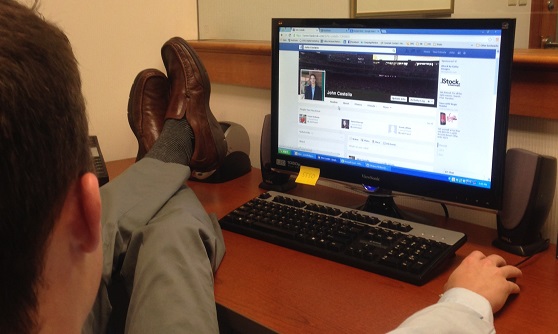Smartphones are everywhere today. People are constantly looking at their phones; texting, taking photos, reading emails, checking Twitter, etc. It’s apparent that as a society we have become obsessed with looking at that little screen. eMarketer stated that the average person looks at their smartphone 150 times per day! The term for this behavior at work is ‘cyberslacking’. Cyberslacking by definition is: “the act of avoiding work and/or other responsibilities by scouring the internet in search of games or other non-work related amusements.” The annual cost to businesses is over $1billion dollars in lost productivity! Additionally, there is another huge potential cost to a business in the form of security breaches.
There are three main ways employee cyberslacking can threaten the security of an organization:
-
Social Networks
There is no such thing as a hacker-proof server. As much as social network sites such as Facebook and LinkedIn say their systems are locked down, the fact that their businesses exist solely on computer servers opens them up to potential hackers. They are targets for malicious intent due to the fact that their users’ personal information is stored and shared on and through their servers. This presents potential issues for a business when their employees use these social networks to share or discuss confidential company related data. There isn’t enough encryption or layers of security to ensure unintended recipients are not listening to a conversation or obtaining confidential work files via a social channel.
-
Third-Party Apps
It’s difficult to acquire viruses and spyware directly through a social media channel. However, that is not true for third-party apps. Third-party apps (i.e. TweetDeck, Hootsuite, buffer) that allow users to schedule social postings in advance on mobile devices are hacked on a regular basis, according to Business Insider. The problem manifests at work when the employee walks in with a personal device and the device “logs into” the network and onto the organization’s Wi-Fi, past any security measures in place on the server. If a malicious third-party app is installed on the employee’s mobile device, it can then access the company network.
-
Email & Internet
Clicking on links on a webpage or within a personal email message are just some of the ways employees can open a Pandora’s Box of problems related to malware, viruses and spyware. Hackers are becoming more and more sophisticated at finding ways to latch on to an organization’s server(s) that provides Wi-Fi access to their staff. It is extremely critical to make sure employees understand how important it is to use common sense while within the organization’s network so that they don’t enable a hacker to gain access.
Prevention is Key for Sound Cyber Security
Don’t let employee cyberslacking allow your organization to become a victim of cyber security breaches. Educate employees and safeguard your internet software and hardware against malicious invasion by:
- Establishing sound social media policies and procedures
- Providing employee education during onboarding and at least once per year with updated safeguards
- Installing strong antivirus, anti-spyware and intrusion detection software on your servers
Be prepared for a potential cyberattack by safeguarding your company and customer data.
SACS Consulting Knows Security
SACS Consulting & Investigative Services, Inc., knows how to assess and prevent cyberslacking security breaches in your organization. Please give us a call at 330-255-1101 to speak with one of our security professionals today!

